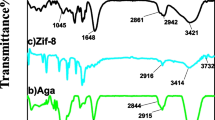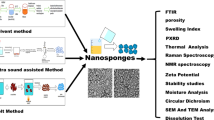Abstract
A poorly water-soluble anticancer drug, curcumin was loaded into cellulose nanocrystals by dissolving it in a commonly used nonionic surfactant medium. Results showed that the drug loading capacity of nanocellulose increased with increasing the surfactant concentration of the medium. The drug loading capacity of nanocellulose in surfactant medium was significantly higher (7.73 mg/g) when compared to the drug loading capacity (3.35 mg/g) in methanolic medium. The nanocellulose drug loaded in surfactant medium (TW/CNC) showed higher drug release compared to the nanocellulose drug loaded in methanolic medium (METH/CNC). It was 8.99 mg/L for TW/CNC and 2.65 mg/L for METH/CNC in simulated gastric fluid. Due to the increased stability of curcumin in acidic medium, all the nanoparticles showed higher drug release in simulated gastric fluid compared to phosphate buffered saline solution. The maximum dissolution of curcumin was 2.13 mg/mL in distilled water containing 4% (w/v) of surfactant. UV–visible spectra revealed that the curcumin retained its chemical activity after in vitro release. From these findings, it is believed that the incorporation of curcumin into nanocellulose in surfactant medium provides a promising approach for delivery of curcumin to stomach and upper intestinal tract.
Graphical abstract











Similar content being viewed by others
References
Ahmed M, Qadir MA, Shafiq MI, Muddassar M, Hameed A, Arshad MN, Asiri AM (2017) Curcumin: synthesis optimization and in silico interaction with cyclin dependent kinase. Acta Pharm 67:385–395
Bashir S, Teo YY, Ramesh S, Ramesh K (2016) Synthesis, characterization, properties of N-succinyl chitosan-g-poly (methacrylic acid) hydrogels and in vitro release of theophylline. Polymer 92:36–49
Bich VT, Thuy NT, Binh NT, Huong NTM, Yen PND, Luong TT (2009) Structural and spectral properties of curcumin and metal-curcumin complex derived from turmeric (Curcuma longa). In: Cat DT, Pucci A, Wandelt K (eds) Physics and engineering of new materials. Springer proceedings in physics. Springer, Berlin, pp 271–278
Chaudhari SP, Dugar RP (2017) Application of surfactants in solid dispersion technology for improving solubility of poorly water soluble drugs. J Drug Del Sci Tec 41:68–77
Cheng C, Peng S, Li Z, Zou L, Liu W, Liu C (2017) Improved bioavailability of curcumin in liposomes prepared using a pH-driven, organic solvent-free, easily scalable process. Rsc Adv 7:25978–25986
Chin SF, Yazid M, Akmar SN, Pang SC (2014) Preparation and characterization of starch nanoparticles for controlled release of curcumin. Int J Polym Sci 2014:340121
Ching YC, Ng TS (2014) Effect of preparation conditions on cellulose from oil palm empty fruit bunch fiber. Bioresource 9(4):6373–6385
Ching YC, Ali ME, Abdullah LC, Choo KW, Kuan YC, Julaihi SJ, Chuah CH, Liou NS (2016) Rheological properties of cellulose nanocrystal-embedded polymer composites: a review. Cellulose 23:1011–1030
de Castro DO, Tabary N, Martel B, Gandini A, Belgacem N, Bras J (2018) Controlled release of carvacrol and curcumin: bio-based food packaging by synergism action of TEMPO-oxidized cellulose nanocrystals and cyclodextrin. Cellulose 25:1249–1263
De R, Kundu P, Swarnakar S, Ramamurthy T, Chowdhury A, Nair GB, Mukhopadhyay AK (2009) Antimicrobial activity of curcumin against Helicobacter pylori isolates from India and during infections in mice. Antimicrob Agents Chemother 53:1592–1597
Fugita RA, Gálico DA, Guerra RB, Perpétuo GL, Treu-Filho O, Galhiane MS, Mendes RA, Bannach G (2012) Thermal behaviour of curcumin. Braz J Therm Anal 1:19–23
Gan S, Zakaria S, Chia CH, Chen RS, Ellis AV, Kaco H (2017) Highly porous regenerated cellulose hydrogel and aerogel prepared from hydrothermal synthesized cellulose carbamate. PLoS ONE 12:e0173743
Gunathilake TMSU, Ching YC, Chuah CH (2017a) Enhancement of curcumin bioavailability using nanocellulose reinforced chitosan hydrogel. Polymers 9:64
Gunathilake TMSU, Ching YC, Kuan YC, Chuah CH, Luqman CH (2017b) Biomedical and microbiological applications of bio-based porous materials: a review. Polymer 9:160. https://doi.org/10.3390/polym9050160
Gunathilake TMSU, Ching YC, Chuah CH, Illias HA, Ching KY, Singh R, Nai-Shang L (2018) Influence of a nonionic surfactant on curcumin delivery of nanocellulose reinforced chitosan hydrogel. Int J Biol Macromol 118:1055–1064
Gustafson HH, Holt-Casper D, Grainger DW, Ghandehari H (2015) Nanoparticle uptake: the phagocyte problem. Nano Today 10:487–510
Ibrahim S, Tagami T, Kishi T, Ozeki T (2018) Curcumin marinosomes as promising nano-drug delivery system for lung cancer. Int J Pharmaceut 540:40–49
Inchai N, Ezure Y, Hongwiset D, Yotsawimonwat S (2015) Investigation on solubility and stability of curcumin in aqueous polysorbate micelle. Int J Manag Appl Sci 3:157–161
Jankun J, Wyganowska-Świątkowska M, Dettlaff K, Jelińska A, Surdacka A, Wątróbska-Świetlikowska D, Skrzypczak-Jankun E (2016) Determining whether curcumin degradation/condensation is actually bioactivation. Int J Mol Med 37:1151–1158
Jobe BA, Richter JE, Hoppo T, Peters JH, Bell R, Dengler WC, DeVault K, Fass R, Gyawali CP, Kahrilas PJ, Lacy BE, Pandolfino JE, Patti MG, Swanstrom LL, Kurian AA, Vela MF, Vaezi M, DeMeester TR (2013) Preoperative diagnostic workup before antireflux surgery: an evidence and experience-based consensus of the esophageal diagnostic advisory panel. J Am Coll Surg 217:586–597
Kamaraj S, Palanisamy UM, Mohamed MSBK, Gangasalam A, Maria GA, Kandasamy R (2018) Curcumin drug delivery by vanillin-chitosan coated with calcium ferrite hybrid nanoparticles as carrier. Eur J Pharm Sci 116:48–60
Khalkhali M, Sadighian S, Rostamizadeh K, Khoeini F, Naghibi M, Bayat N, Habibizadeh M, Hamidi M (2015) Synthesis and characterization of dextran coated magnetite nanoparticles for diagnostics and therapy. Bioimpacts 5:141
Kolev TM, Velcheva EA, Stamboliyska BA, Spiteller M (2005) DFT and experimental studies of the structure and vibrational spectra of curcumin. Int J Quantum Chem 102:1069–1079
Löbmann K, Svagan AJ (2017) Cellulose nanofibers as excipient for the delivery of poorly soluble drugs. Int J Pharm 533:285–297
Mohan PK, Sreelakshmi G, Muraleedharan C, Joseph R (2012) Water soluble complexes of curcumin with cyclodextrins: characterization by FT-Raman spectroscopy. Vib Spectrosc 62:77–84
Novo LP, Bras J, García A, Belgacem N, Curvelo AA (2015) Subcritical water: a method for green production of cellulose nanocrystals. ACS Sustain Chem Eng 3:2839–2846
Ntoutoume GMAN, Granet R, Mbakidi JP, Brégier F, Léger DY, Fidanzi-Dugas C, Lequart V, Joly N, Liagre B, Chaleix V, Sol V (2016) Development of curcumin–cyclodextrin/cellulose nanocrystals complexes: new anticancer drug delivery systems. Bioorg Med Chem Lett 26:941–945
O’Toole MG, Henderson RM, Soucy PA, Fasciotto BH, Hoblitzell PJ, Keynton RS, Ehringer WD, Gobin AS (2012) Curcumin encapsulation in submicrometer spray-dried chitosan/Tween 20 particles. Biomacromol 13:2309–2314
Ortiz-Tafoya M, Tecante A (2018) Physicochemical characterization of sodium stearoyl lactylate (SSL), polyoxyethylene sorbitan monolaurate (Tween 20) and κ-carrageenan. Data Brief 19:642–650
Pandav S, Lokhande A, Naik J (2013) Assessment of microparticulate drug delivery system of propranolol hydrochloride prepared by multiple solvent emulsion technique. Int J Pharm Pharm Sci 5:831–835
Phanthong P, Ma Y, Guan G, Abudula A (2015) Extraction of nanocellulose from raw apple stem. J Jpn Inst Energy 94:787–793
Poornima B, Prasad K, Bharathi K (2016) Evaluation of solid-state forms of curcuminoids. Int J Pharm Sci Res 7:4035
Rangel-Yagui CO, Pessoa A Jr, Tavares LC (2005) Micellar solubilization of drugs. J Pharm Pharm Sci 8:147–163
Rao JV, Rao M (2011) Increased solubility and stability of curcumin in lactic acid. Int J Pharm Bio Sci 1:50–53
Ratanajiajaroen P, Ohshima M (2012) Synthesis, release ability and bioactivity evaluation of chitin beads incorporated with curcumin for drug delivery applications. J Microencapsul 29:549–558
Rizvi SA, Saleh AM (2017) Applications of nanoparticle systems in drug delivery technology. Saudi Pharm J 26(1):64–70
Sadeghifar H, Filpponen I, Clarke SP, Brougham DF, Argyropoulos DS (2011) Production of cellulose nanocrystals using hydrobromic acid and click reactions on their surface. J Mater Sci 46:7344–7355
Sahlin K, Forsgren L, Moberg T, Bernin D, Rigdahl M, Westman G (2018) Surface treatment of cellulose nanocrystals (CNC): effects on dispersion rheology. Cellulose 25:331–345
Sampath UTM, Ching YC, Chuah CH, Singh R, Lin PC (2017) Preparation and characterization of nanocellulose reinforced semi-interpenetrating polymer network of chitosan hydrogel. Cellulose 24:2215–2228
Sanphui P, Goud NR, Khandavilli UR, Bhanoth S, Nangia A (2011) New polymorphs of curcumin. Chem Commun 47:5013–5015
Santos AM, Lopes T, Oleastro M, Pereira T, Alves CC, Seixas E, Chaves P, Machado J, Guerreiro AS (2018) Cyclooxygenase inhibition with curcumin in Helicobacter pylori infection. Nutrire 43:7
Singh PK, Wani K, Kaul-Ghanekar R, Prabhune A, Ogale S (2014) From micron to nano-curcumin by sophorolipid co-processing: highly enhanced bioavailability, fluorescence, and anti-cancer efficacy. Rsc Adv 4:60334–60341
Wang YJ, Pan MH, Cheng AL, Lin LI, Ho YS, Hsieh CY, Lin JK (1997) Stability of curcumin in buffer solutions and characterization of its degradation products. J Pharmaceut Biomed 15:1867–1876
Yallapu MM, Dobberpuhl MR, Maher DM, Jaggi M, Chauhan SC (2012) Design of curcumin loaded cellulose nanoparticles for prostate cancer. Curr Drug Metab 13:120–128
Zsila F, Bikádi Z, Simonyi M (2004) Circular dichroism spectroscopic studies reveal pH dependent binding of curcumin in the minor groove of natural and synthetic nucleic acids. Org Biomol Chem 2:2902–2910
Acknowledgments
The authors would like to acknowledge the financial support from the Ministry of Education of Malaysia FRGS-FP053-2015A and PRGS-PR005-2017A and University of Malaya PG160-2016A, ST017-2018, GPF 033A-2018, RU018I-2016 and International Funding AUA Scholars IF025-2018 for the success of this project.
Author information
Authors and Affiliations
Corresponding author
Additional information
Publisher's Note
Springer Nature remains neutral with regard to jurisdictional claims in published maps and institutional affiliations.
Rights and permissions
About this article
Cite this article
Ching, Y.C., Gunathilake, T.M.S.U., Chuah, C.H. et al. Curcumin/Tween 20-incorporated cellulose nanoparticles with enhanced curcumin solubility for nano-drug delivery: characterization and in vitro evaluation. Cellulose 26, 5467–5481 (2019). https://doi.org/10.1007/s10570-019-02445-6
Received:
Accepted:
Published:
Issue Date:
DOI: https://doi.org/10.1007/s10570-019-02445-6




